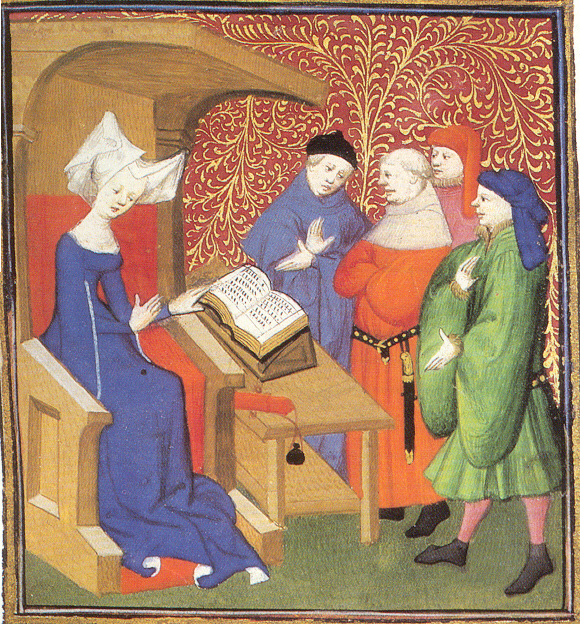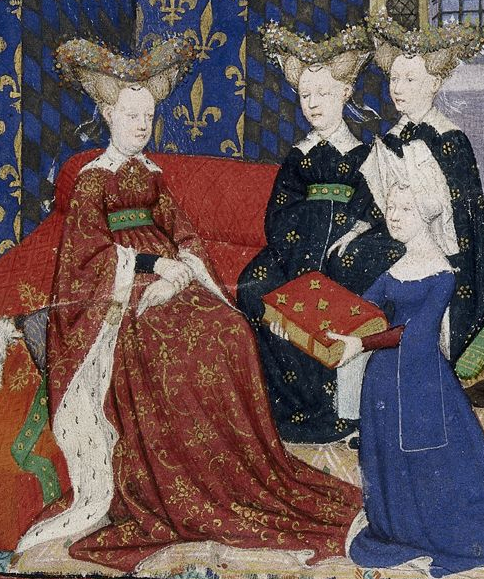Typically, women of the Middle Ages were seen and not heard, at least in terms of literature. Christine de Pizan, however, bucked that trend.
Born in 1364 in Venice, Italy, Christine was the daughter of a court astrologer, Tommaso de Benvenuto da Pizzano. Growing up in the court of King Charles V of France, and with an intellectual father, she was exposed to a wide range of subjects, as well as an extensive library, and educated herself in a variety of languages, the humanities, and literature.
However, like all good medieval upper-class women, she married fairly young (at the age of 15) and started a family. When her father died, and then her husband a few years later, she was left to pay off her father’s debts and support her own family, as well as her mother and a niece. She turned to writing in order to do so.

She began by writing ballads and drew the attention of certain well-to-do patrons, including Louis I and Philip the Bold and John the Fearless, the latter two Dukes of Burgundy. A female writer was a novelty, and several clients had her compose songs about their own romantic adventures. She also wrote a biography of King Charles V, published in 1404. But she was particularly well known for her poetic works in which she would sometimes reflect on her grief over her husband’s death.
Her most modern works, however, and those for which she is best remembered, are The Book of the City of Ladies (La cité des dames), published in 1404, and The Treasure of the City of Ladies (Le livre du trésor de la cité des dames), published the following year. The former is thought to be one of the first feminist texts, and is still read widely in both medieval studies and women’s studies classes.

In The Book of the City of Ladies, de Pizan used vernacular French, making the work more accessible than other books written in Latin. It was written as a counter piece to Jean de Meun’s well-known Roman de la Rose, a work of courtly literature. De Pizan disputes de Meun’s statements about women in her creation of an allegorical city of ladies. Here, famous women of history live in the City of Ladies, which is, quite literally, her book. Each famous woman becomes a part of the foundation for the fictional city, as well as her argument–namely, that women are to be valued in society and deserve to be educated.
A great many women feature in her work, including Minerva; the Queen of Sheba; Isis; biblical women, such as Esther and Rebecca; women of mythology, including Medusa and Helen of Troy; and virtuous women and saints, including the Virgin Mary and Saint Cecilia.
The book includes a discussion between de Pizan and the three virtues of Reason, Rectitude, and Justice. They help build the city’s foundations and houses and choose who will live within its walls. Each woman exemplifies the positive influences women have on society.

When one thinks of well-known feminists, names like Gloria Steinem and Betty Friedan are more likely to come up than Christine de Pizan. But she was a woman unlike most others in her era. Yes, certainly, some women (and likely a few men) agreed with her. But they weren’t–or weren’t allowed to be–outspoken about it.
Like Malala Yousafzai, the support of her education by her open-minded father allowed de Pizan to speak up and be heard, to write and be read, and to be a feminist before the word existed. Christine de Pizan is proof that feminism is nothing new, and that women have been arguing for equality for centuries.
Patricia Grimshaw is a self-professed museum nerd, with an equal interest in both medieval and military history. She received a BA (Hons) from Queen’s University in Medieval History, and an MA in War Studies from the Royal Military College of Canada, and completed a Master of Museum Studies at the University of Toronto before beginning her museum career. She has lived and traveled all over Canada and Europe.
